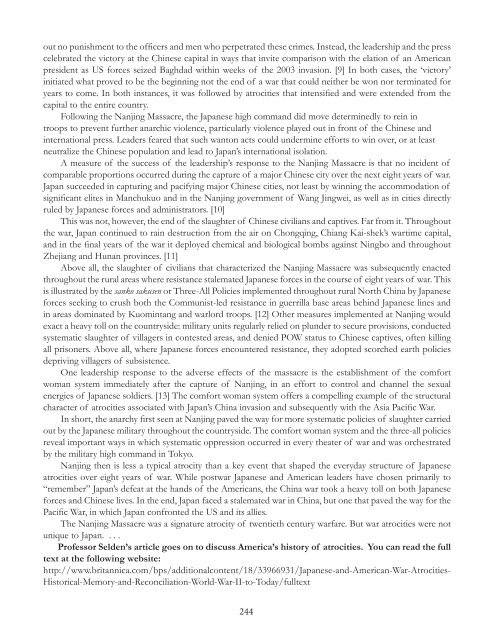Download - Canada ALPHA
Download - Canada ALPHA
Download - Canada ALPHA
You also want an ePaper? Increase the reach of your titles
YUMPU automatically turns print PDFs into web optimized ePapers that Google loves.
out no punishment to the offi cers and men who perpetrated these crimes. Instead, the leadership and the press<br />
celebrated the victory at the Chinese capital in ways that invite comparison with the elation of an American<br />
president as US forces seized Baghdad within weeks of the 2003 invasion. [9] In both cases, the ‘victory’<br />
initiated what proved to be the beginning not the end of a war that could neither be won nor terminated for<br />
years to come. In both instances, it was followed by atrocities that intensifi ed and were extended from the<br />
capital to the entire country.<br />
Following the Nanjing Massacre, the Japanese high command did move determinedly to rein in<br />
troops to prevent further anarchic violence, particularly violence played out in front of the Chinese and<br />
international press. Leaders feared that such wanton acts could undermine efforts to win over, or at least<br />
neutralize the Chinese population and lead to Japan’s international isolation.<br />
A measure of the success of the leadership’s response to the Nanjing Massacre is that no incident of<br />
comparable proportions occurred during the capture of a major Chinese city over the next eight years of war.<br />
Japan succeeded in capturing and pacifying major Chinese cities, not least by winning the accommodation of<br />
signifi cant elites in Manchukuo and in the Nanjing government of Wang Jingwei, as well as in cities directly<br />
ruled by Japanese forces and administrators. [10]<br />
This was not, however, the end of the slaughter of Chinese civilians and captives. Far from it. Throughout<br />
the war, Japan continued to rain destruction from the air on Chongqing, Chiang Kai-shek’s wartime capital,<br />
and in the fi nal years of the war it deployed chemical and biological bombs against Ningbo and throughout<br />
Zhejiang and Hunan provinces. [11]<br />
Above all, the slaughter of civilians that characterized the Nanjing Massacre was subsequently enacted<br />
throughout the rural areas where resistance stalemated Japanese forces in the course of eight years of war. This<br />
is illustrated by the sanko sakusen or Three-All Policies implemented throughout rural North China by Japanese<br />
forces seeking to crush both the Communist-led resistance in guerrilla base areas behind Japanese lines and<br />
in areas dominated by Kuomintang and warlord troops. [12] Other measures implemented at Nanjing would<br />
exact a heavy toll on the countryside: military units regularly relied on plunder to secure provisions, conducted<br />
systematic slaughter of villagers in contested areas, and denied POW status to Chinese captives, often killing<br />
all prisoners. Above all, where Japanese forces encountered resistance, they adopted scorched earth policies<br />
depriving villagers of subsistence.<br />
One leadership response to the adverse effects of the massacre is the establishment of the comfort<br />
woman system immediately after the capture of Nanjing, in an effort to control and channel the sexual<br />
energies of Japanese soldiers. [13] The comfort woman system offers a compelling example of the structural<br />
character of atrocities associated with Japan’s China invasion and subsequently with the Asia Pacifi c War.<br />
In short, the anarchy fi rst seen at Nanjing paved the way for more systematic policies of slaughter carried<br />
out by the Japanese military throughout the countryside. The comfort woman system and the three-all policies<br />
reveal important ways in which systematic oppression occurred in every theater of war and was orchestrated<br />
by the military high command in Tokyo.<br />
Nanjing then is less a typical atrocity than a key event that shaped the everyday structure of Japanese<br />
atrocities over eight years of war. While postwar Japanese and American leaders have chosen primarily to<br />
“remember” Japan’s defeat at the hands of the Americans, the China war took a heavy toll on both Japanese<br />
forces and Chinese lives. In the end, Japan faced a stalemated war in China, but one that paved the way for the<br />
Pacifi c War, in which Japan confronted the US and its allies.<br />
The Nanjing Massacre was a signature atrocity of twentieth century warfare. But war atrocities were not<br />
unique to Japan. . . .<br />
Professor Selden’s article goes on to discuss America’s history of atrocities. You can read the full<br />
text at the following website:<br />
http://www.britannica.com/bps/additionalcontent/18/33966931/Japanese-and-American-War-Atrocities-<br />
Historical-Memory-and-Reconciliation-World-War-II-to-Today/fulltext<br />
244


